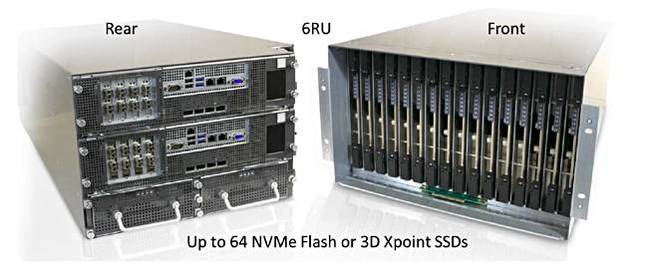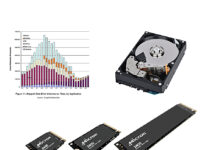Vexata, an NVMe flash array startup, has submitted its first product for the SPC-2 benchmarking and the results are… fifth best overall performance number and second-best price/performance rating.
The Storage Performance Council’s SPC-2 benchmark measures overall storage array performance in throughput (MB/sec) and (discounted) price/performance terms. These numbers are calculated from three component workloads: large file processing; large database query; and video-on-demand.
Vexata’s VX100-F box is a 6U enclosure with two active:active controllers using either up to 64 NVMe SSDs or Optane SSDs (VX-100M) that interacts with host servers using up 16 x 32Gbit/s Fibre Channel ports. The system alternatively supports 16 x 40GitbE NVMe over Fabric ports.

Internally it has a lossless Ethernet fabric connecting dual front-end controller/routers and backend Enterprise Storage Modules – proprietary drives in other words – which have NVMe SSDs and front-end data controllers handling I/O scheduling and metadata management. Drives are accessed in parallel.

For this SPC-2 run the VX100-F was configured with 16 x Enterprise Storage Modules with 4x 1TB drives each; 64TB, of which 20TB was the addressable storage capacity; 20,615.843 GB to be precise. Some 23,970.195 GB (37.45 per cent was used for overhead and metadata, and 1,392.806 GB (2.18 per cent) for data protection.
Its SPC-2 MB per sec rating was 49,042.39. The price/performance number is calculated by dividing the total system price of $262,572.59 by the MB/sec rating, which produces $5.35 per SPC-2 MBPS.
A chart of SPC-2 results (Price/Performance vs Aggregate MB/sec) looks a tad busy:

Basically the lower down the vertical axis the lower the cost, and the further along the horizontal axis the higher the performance.
Here is a highlighted view of the lower part of the chart to show things more clearly:

Vexata’s price/performance is in the same area as NetApp’s EF570 but it has a much higher MB/sec performance number.
The VX-100 connected to 8 x Supermicro host servers across 16 x 32Gbit/s Fibre Channel ports in this SOC-run. We would expect an NVMe-oF connection to be much faster than Fibre Channel. We look forward to such a test result, and also to ones using Optane SSDs. Both should send the MB/sec number much higher, and the price/performance rating lower, for the NVMe-oF flash drive one at least.








